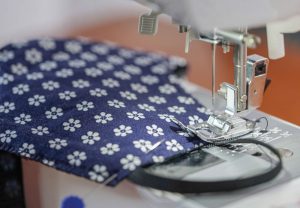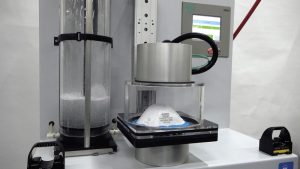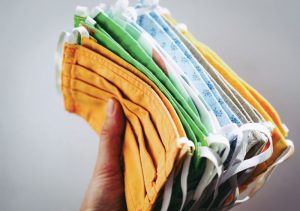
sewers, responded to the need for
barrier face coverings.
Standardized testing of face coverings may be beneficial in reducing public confusion and misinformation about performance.
戴维斯·李博士;Erin Kirkpatrick博士;艾米莉·菲茨赫里斯博士;Ariana Levitt博士;迈克尔·波森(Michael Posson),M.P.H.,CIH;瑞安·西斯基(Ryan Siskey)和马克·罗伯茨博士
during the pandemic, there has been a sharp increase in demand for face coverings to reduce the risk of infection by the novel coronavirus (SARS-CoV-2), creating both opportunity and challenge for textile manufacturers. As a result, there is growing awareness that a clear regulatory difference exists between personal protective equipment (PPE) used in an occupational or healthcare setting — N95 respirators and surgical masks for example — and barrier face coverings that may be used by the general public such as the face coverings as described by the Centers for Disease Control and Prevention (CDC).1While established standards and requirements already exist for many types of PPE, this was not the case for the barrier face coverings that have been in wide-use by the general public in response to the COVID-19 pandemic.2
纺织社区对英航的必要性rrier face coverings in unprecedented fashion. This has in turn driven the need for standardized testing to help educate the public and to reduce confusion about performance. Many universities, companies and testing laboratories have developed novel approaches for evaluating the efficacy of barrier face coverings, with particular emphasis on inexpensive and easy to implement methods. Standardized methods for evaluating face covering efficacy have also emerged. ASTM F3502-213for example, was developed and published in just eight months in response to the critical need for objective test methods. The purpose was to provide a test method that evaluates the ability of a face covering to act as a barrier to the transfer of aerosolized particles and large droplets of saliva and/or mucus, while also being reasonably comfortable to the wearer.4The evaluation places a focus on the filtration efficiency, breathability, fit and expected usage conditions.5
This article reviews the importance of standardized test methods, and some of the key issues related to face coverings. At the same time, it should be noted that even with standardized testing to quantify performance, individual use factors — such as wearing the mask correctly, facial fit, usage time and other factors — also impact the efficacy of the barrier covering performance. These factors are beyond the scope of this article.
Why Test Standards Are Needed
The increased use of face coverings during the COVID-19 pandemic led to a surge of studies on the filtration efficacy of various face coverings and materials. In September of 2020, a paper was published detailing a “simple optical measurement method” using an expanded laser beam and a cell phone camera to evaluate the efficacy of different masks.6The study examined a variety of samples and ranked the relative droplet count emerging from the coverings. The study authors concluded that “speaking through some masks — particularly the neck gaiter — seemed to disperse the largest droplets” causing an increase in droplet count compared to the “no mask” control. The authors concluded that smaller droplets dispersed from larger droplets remained airborne for longer periods of time, suggesting that the use of neck gaiters may be counterproductive to the wearer. Even though limitations of the detection method were discussed in the article, many news outlets reported on the implication that in some cases, a neck gaiter may be worse than no mask at all.7,8,9,10
These media conclusions have since been disproven by a number of different studies showing that neck gaiters can be effective at blocking a range of particle sizes, especially when worn as a double layer.11,12此外,在初始研究中检测到的颗粒数量越高,一些导致一些人推测这是纤维从织物中脱落的结果。13However, even with these new results, the controversy of “Gaitergate” left the public confused over the efficacy of face covering options during a time when supply chain constraints were making it necessary for the general public to use all available options.

chloride aerosol testing.
关键的问题
Efforts to evaluate the performance of textile face coverings — for filtration efficiency and breathability, for example — have shed light on the importance of standardizing the methods used to evaluate these coverings. Standardized methods for evaluating face masks help to ensure the availability of consistent methodologies for comparing barrier face covering technologies. They also help to assess the various parameters that can affect both performance results and variability.
以下几点代表了可能影响屏障面部覆盖的性能结果的产品和测试参数的示例:
- 纺织结构: Numerous studies have shown that fiber content and fabric structure can significantly impact filtration efficiency and breathability.14,15,16For example, researchers compared the performance of two cotton samples with different weave densities, or threads per inch (TPI), and found that the denser weave had a higher filtration efficiency.17尽管这不足为奇,但许多研究并未描述纺织品覆盖物的结构和纤维含量,因此很难解释结果并比较研究之间和研究之间的结果。新的ASTM F3502-21需要建筑的主要材料,包括在产品包装上明确打印的材料和纤维内容。
- Sample Conditioning: It is common practice to pre-condition textile samples to minimize test variability. This is done by pre-conditioning test samples to a standard humidity and temperature for a prescribed period of time prior to testing. ASTM F3502-21 requires pre-conditioning test samples at 85 ± 5% relative humidity and 38 ± 2.5°C for 25 ± 1 hour.18,19This is particularly important for textile face coverings, as temperature and humidity may influence the performance of substrate materials — such as polyester, nylon or cotton — differently.
- Air Flow Rate:空气流量已显示出影响纺织面部覆盖物的测得的效率。较慢的流速通常会提高过滤效率。20,21理想情况下,测试流量应标准化,并应模仿呼吸速率,以使测试结果现实。纺织面部覆盖的压力下降是一个相关参数,可以影响过滤效率和透气性。ASTM F3502-21指定每分钟85 + 4升的流速,如果样品平坦地躺在过滤器中,则调整流速以达到每秒10 + 0.5厘米的面部速度。22
- Mask Fit: In use, mask fit is critical to the overall performance of the textile face covering as gaps between the wearer’s face and the textile allow respiratory droplets and aerosols to escape.23,24Quantifying and standardizing mask fit is especially challenging and is often not sufficiently examined. ASTM F3502-21 addresses the importance of mask fit with a leakage assessment that is described in the method. The standard also permits supplemental quantitative testing to determine the leakage ratio based on ASTM F3407: Standard Test Method for Respirator Fit Capability for Negative-Pressure Half-Facepiece Particulate Respirators.25
- Charge Neutralizing Aerosol Particles: Charged particles can impact filtration efficiency due to electrostatic interactions with the mask material and other nearby particles.26,27,28For instance, aerosols that contain moisture can change diameter during testing, influencing the measured particle size distribution of the filtered particles and the filtration efficiency.29,30In order to mitigate these effects, particles need to be charge neutralized and dried prior to testing. This is a common practice used in standards evaluating filtration efficiency, such as EN 182231, ISO 2946332, ASTM F3502-2133, and NIOSH No. TEB-APR-STP-0059.34

自制面具,可能有助于减少公众混乱和
misinformation about performance.
结论
尽管已经存在评估PPE面罩功效的测试方法多年,但它们只是出现在屏障面部覆盖范围内。标准化测试可能有助于减少公众对绩效的混乱和错误信息。标准化测试,例如解决关键技术问题的ASTM F3502-21,例如本文确定的少数示例,应为制造商和消费者提供更清楚的面部覆盖能力。
References:
1“Recommendation Regarding the Use of Cloth Face Coverings, Especially in Areas of Significant Community-Based Transmission” Centers for Disease Control and Prevention, reviewed 3 April 2020, www.cdc.gov/coronavirus/2019-ncov/prevent-getting-sick/cloth-face-cover.html. Accessed 21 April 2020.
2“促进个人防护设备(PPE)安全,质量和创新的全球合作” ASTM白皮书,2021年2月,https://www.astm.org/about/about/ppe-white-white-paper-paper-r2.pdf。2021年5月25日访问。
3ASTM F3502-21,屏障面部覆盖物的标准规范,ASTM International,West Conshohocken,宾夕法尼亚州,2021年,www.astm.org。
4Plotz, Chris, INDA, Director of Education & Technical Affairs, personal communication.
5Peachman,瑞秋。“新标准日常面具s will Help People Pick Covid-19 Face Coverings.” The Washington Post, 1 March 2021. https://www.washingtonpost.com/health/new-covid-19-cloth-mask-standards/2021/02/26/307aa398-730e-11eb-85fa-e0ccb3660358_story.html. Accessed 25 May 2021.
6Fischer, Emma, et al. “Low-Cost Measurement of Face Mask Efficacy for Filtering Expelled Droplets During Speech.” Science Advances, 2 September 2020. 10.1126/sciadv.abd3083.
7Morris, Emily. “Facial Masks that Miss the Mark.” The Oakland Post, 17 February 2021. https://oaklandpostonline.com/34628/opinion/facial-masks-that-miss-the-mark/. Accessed 25 May 2021.
88Kelleher, Suzanne. “Neck Gaiters Do Not Curb COVID-19, Study Finds.” Forbes, 11 August 2020. https://www.forbes.com/sites/suzannerowankelleher/2020/08/11/neck-gaiters-do-not-curb-covid-19-study-finds/?sh=5086abdd204d. Accessed 25 May 2021.
9Chiu, Allyson. “Wearing a Neck Gaiter May Be Worse Than No Mask At All, Researchers Find.” The Washington Post, 11 August 2020. https://www.washingtonpost.com/lifestyle/wellness/mask-test-duke-covid/2020/08/10/4f2bb888-db18-11ea-b205-ff838e15a9a6_story.html. Accessed 25 May 2021.
10Baskar, Pranav。“我该如何弥补My Face? A Deeper Look Into Neck Gaiters and Face Shields.” NPR, 14 August 2020. https://www.npr.org/sections/goatsandsoda/2020/08/14/902244060/how-should-i-cover-my-face-a-deeper-look-into-neck-gaiters-and-face-shields. Accessed 25 May 2021.
12Lindsley,William等。“面罩,脖子步态和面罩的功效可减少模拟咳嗽产生的气溶胶的驱逐。”气雾科学技术,2021年1月7日。10.1080/02786826.2020.1862409。
13https://twitter.com/CappaSnappa/status/1296494910355451905
14Konda,Abhiteja等。“用于呼吸布面膜的常见织物的气溶胶过滤效率。”ACS Nano,2020年4月24日,10.1021/acsnano.0C03252。
15Zhao, Mervin, et al. “Household Materials Selection for Homemade Cloth Face Coverings and their Filtration Efficiency Enhancement with Triboelectric Charging.” Nano Letters, 2 June 2020. 10.1021/acs.nanolett.0c02211.
16Zangmeister,Christopher等。“用面膜材料对纳米级气溶胶的过滤效率用于减慢SARS-COV-2的传播。”ACS Nano,2020年6月25日。101021/acsnano.0C05025。
17Konda,Abhiteja等。“用于呼吸布面膜的常见织物的气溶胶过滤效率。”ACS Nano,2020年4月24日,10.1021/acsnano.0C03252。
18ASTM D1776-04,调节和测试纺织品的标准实践,ASTM International,West Conshohocken,宾夕法尼亚州,2021年,www.astm.org。
19ASTM F3502-21. See ASTM F3502-21, Standard Specification for Barrier Face Coverings, ASTM International, West Conshohocken, PA, 2021, www.astm.org.
20Kumar,Amit等。“使用环境和PAO气溶胶随后采用不同的灭菌方法评估各种各样的面罩的过滤功效。”Medrxiv,2020年10月27日。10.1101/2020.10.23.20218073。
21Stevens, Gregory and Moyer, Ernest. “’Worst Case’ Aerosol Testing Parameters: I. Sodium Chloride and Dioctyl Phthalate Aerosol Filter Efficiency as a Function of Particle Size and Flow Rate.” American Industrial Hygiene Association Journal, May 1989.
22参见ASTM F3502-21,《屏障面部覆盖物的标准规范》,ASTM International,West Conshohocken,宾夕法尼亚州,2021年,www.astm.org。
23Aydin, Onur, et al. “Performance of fabrics for home-made masks against the spread of COVID-19 through droplets: A quantitative mechanistic study.” Extreme Mechanics Letters, 11 August 2020. 10.1016/j.eml.2020.100924.
24Zhao, Mervin, et al. “Household Materials Selection for Homemade Cloth Face Coverings and their Filtration Efficiency Enhancement with Triboelectric Charging.” Nano Letters, 2 June 2020. 10.1021/acs.nanolett.0c02211.
25ASTM F3407-20, Standard Test Method for Respirator Fit Capability for Negative-Pressure Half-Facepiece Particulate Respirators, ASTM International, West Conshohocken, PA, 2020, www.astm.org.
27Freitag, Steffen et al. “Why simple face masks are unexpectedly efficient in reducing viral aerosol transmissions.” MedRxIv, 4 December 2020. 10.1101/2020.12.03.20243063.
28Mueller,Amy等。“用于比较织物掩模颗粒去除效率的定量方法,作为PPE标准手术掩模的替代方法。”Matter,2020年9月2日。101016/j.matt.2020.07.006。
29规则,安娜等。“评论呼吸布面膜中常见织物的气溶胶过滤效率:质疑其发现。ACS Nano,2020年9月22日。10.1021/acsnano.0C05265。
30Mueller,Amy等。“用于比较织物掩模颗粒去除效率的定量方法,作为PPE标准手术掩模的替代方法。”Matter,2020年9月2日。101016/j.matt.2020.07.006。
31EN 1822: High Efficiency Air Filters (Efficient Air Filters (EPA), High Efficiency Air Filters (HEPA), Ultra Low Penetration Air Filters (ULPA)). ICS 13.040.40. 14 January 2019.
32ISO 29463: High-Efficiency Filters and Filter Media for Removing Particles in Air, September 2017, www.iso.org.
33ASTM F3502-21,屏障面部覆盖物的标准规范,ASTM International,West Conshohocken,宾夕法尼亚州,2021年,www.astm.org。
34National Institute for Occupational Safety and Health. “Determination of Particulate Filter Efficiency Level for N95 Series Filters Against Solid Particulates for Non-Powered, Air-Purifying Respirators.” NIOSH Procedure No. TEB-APR-STP-0059, Rev. 3.2, 13 December 2019.
Editor’s Note: Dr. Davis Lee is senior managing scientist, Dr. Erin Kirkpatrick is managing scientist, Dr. Emily Fitzharris is associate and Dr. Ariana Levitt is a scientist in the Polymer Science & Materials Chemistry practice of Exponent Inc. — a multi-disciplinary engineering and scientific consulting firm. Ryan Siskey, M.S., is the principal and office director of Exponent’s Biomedical Engineering & Sciences practice. Michael Posson, M.P.H., CIH, is senior managing scientist and Dr. Mark Roberts is principal scientist at Exponent’s Health Sciences practice.
July/August 2021




